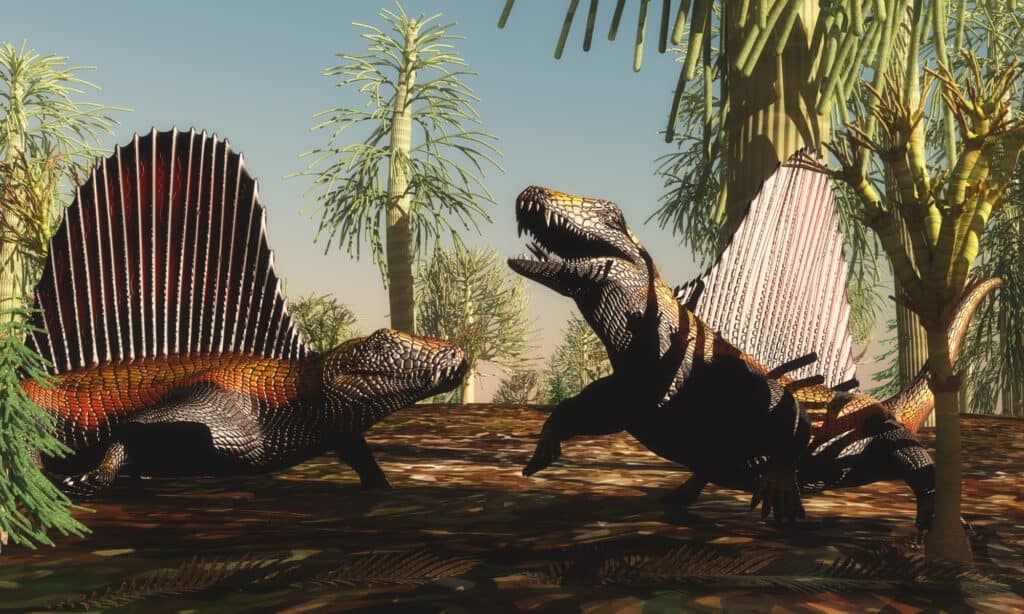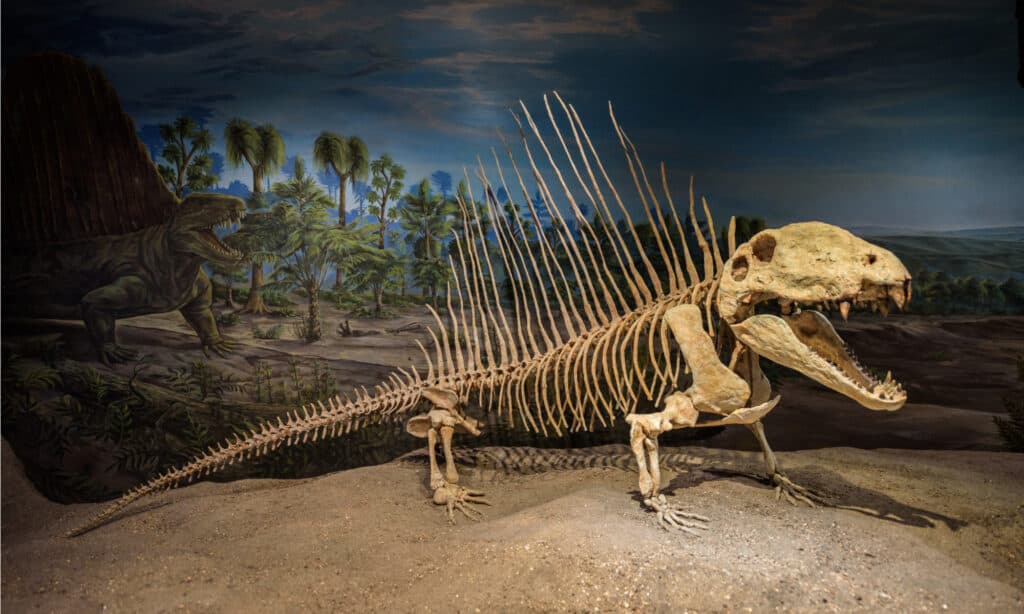You probably know about Dimetrodon because you read about it in a dinosaur book or found a plastic toy in the toy store. It is a common misconception about Dimetrodon that it lived among dinosaurs when, in fact, it wasn’t even a reptile. This prehistoric predator is closer to humans than dinosaurs since it belonged to a group called synapsids, which includes all living mammals and extinct mammals that date back to some 305 years ago.
The Dimetrodon lived in North America and Europe between 295 million to 275 million years ago during the Permian period. It predated dinosaurs by about 60 million years. This meant that the first dinosaur evolved long after the Dimetrodon became extinct. The period between Dimetrodon and the first dinosaurs is almost the same as the time that separates Tyrannosaurus Rex and humans. Many believed that the Dimetrodon wouldn’t have survived living with dinosaurs despite its sharp teeth.
But the Dimetrodon is just as popular as dinosaurs. It is even more popular than some of these massive reptiles that once roamed the Earth. It looked like Spinosaurus because of the sail-like protruding on its back. That sail made this predator one of the most recognizable extinct animals.
Dimetrodon, in Summary
| Species | 15 known species |
| Length | More than 11.5 feet (sometimes, up to 15 feet) |
| Weight | 550 lbs (226 kg) |
| Habitat | Dry and arid / deserts and scrublands |
| Diet | Carnivore |
Description and Size
The Dimetrodon is not entirely a reptile. Instead, it belonged to the order called Pelycosauria, which is a group of mammal-like reptiles that shared the same lineage as humans. The Dimetrodon had many mammal-like characteristics, such as the single lower jawbone, large brains, two to three kinds of teeth for chewing, and three small ear bones.
The Dimetrodon walked with a distinctly ambling, splay-footed crocodilian gait, rather than the upright vertical posture of the comparably sized quadrupedal dinosaurs that evolved tens of millions of years later. The locked-in orientation of the limbs is one of the distinguishing characteristics of dinosaurs.
Sail
The most recognizable feature of the Dimetrodon is the large “sail” on its back. Presumably, this sail was formed by elongated vertebral spines. These spines are then connected by a membrane containing blood vessels. There are many theories about this sail, the most popular of which are that it was used for temperature regulation, attracting mates, and frightening other mammals.
Some even suggested that the sail was used for defense, but this doesn’t hold fast considering that the Dimetrodon was a medium- to large-sized apex predator of their time. Different species of the Dimetrodon ranged in length from 5.5 to 15 feet, and they weighed between 30 and 250 kg. By comparison, the amphibians Diadectes and Eryops only reached 90 kg in adulthood.
Besides, while the sail looked strong, it had a weak structure. The upper parts lacked muscles and were embedded in thin and soft tissue. It is doubtful that the Dimetrodon developed such a weak defense mechanism against predators that may not have even existed.
It is hard to understand the natural function of the sail since it is not seen in today’s mammals and reptiles. The closest animal that had it was also extinct; it was the middle cretaceous Spinosaurus. In the Dimetrodon, some experts believed the sail could have been sexual in nature. Meaning, that male Dimetrodons with bigger sails were preferred by female Dimetrodons.
Another theory about the sail is that it was used in thermoregulation. This theory was based on the fact that the sail could’ve been made up of many blood vessels that could help regulate the creature’s body temperature. According to some scientists, the sail could have been used to soak up sunlight during the daytime and use this excess heat at night.

T
wo Dimetrodon fighting over territory or mates. The sail of the Dimetrodon was probably sexual in nature, with females choosing the male with the biggest sail.©Catmando/Shutterstock.com
Skull
The Dimetrodon skull is why scientists believe it to be closer to humans than to dinosaurs, even though it looked like a short Spinosaurus at times. The head is monstrous, but fossils showed that there was only one hole behind the Dimetrodon’s eye socket. This defined a group of vertebrates called synapsids. Modern mammals, including humans, are synapsids. Men and Dimetrodon share this particular feature.
On the other hand, dinosaurs have two holes behind their eye sockets. That is why they are called diapsids. In Dimetrodons and humans, this single large hole is called the temporal fenestra. You can find some attachments between the lower jaw muscles and the skull. Paleontologists look at the number of holes behind a creature’s eye sockets to know where they belong.
The lineage of synapsids and reptiles evolved 324 million years ago. There was reportedly a lizard-like common ancestor between the Dimetrodon and other mammals and reptiles like the dinosaurs. This is why early synapsids like the Dimetrodon looked like a reptile before they eventually evolved into something that resembled humans.
Teeth
The name Dimetrodon was derived from the creature’s two different types of teeth. After all, Dimetrodon means “two-measure teeth” — shearing teeth and sharp canine teeth. This was the first animal with sharp and laterally compressed teeth with serrated edges called ziphodont. But not all Dimetrodons had the same set of teeth. With over 15 species, they differed in teeth depending on the times they lived and evolved. The bigger they were, the sharper and deadlier their teeth became.
Experts studied three different species of Dimetrodon with three different sets of teeth. The Dimetrodon milleri was the oldest and smallest of the species. It had straight, sharp teeth with cutting edges. The Dimetrodon limbastus came later, but by then, it was already larger than the milleri, and it had small serrations in the enamel on some of its teeth. These serrations could cut through skin and muscle better than the teeth of the milleri.
The third species the scientists studied were the Dimetrodon grandis. The prominent denticles with serrated edges were similar to the teeth of predatory dinosaurs. This set of teeth was perfect for cutting through flesh and even bones.
Scientifically, the Dimetrodon is said to have two types of teeth. The first was the incisor-like teeth used for gripping and stabbing canines. The second was the recurved teeth at the rear that could shear through flesh. Reports said there were even hidden teeth on the roof of the mouth to hold their prey captive and pin them down as the Dimetrodon ate through flesh.
The evolution of the Dimetrodon’s teeth is often linked to the appearance of larger predators. The competition became tough when it came to their prey, forcing this prehistoric creature to evolve. The best way to survive during that time was by developing its teeth.
What Did the Dimetrodon Eat?
Because they lived so long ago, even researchers are having a hard time determining their diet. They were almost sure that this prehistoric predator was a carnivore because of the appearance of its teeth. Those sharp-edged teeth would have helped tear through skin and flesh.
Some believed that the Dimetrodon ate fish and tetrapods, including reptiles and amphibians. Others said its species could have also feasted on freshwater sharks and other amniotes and the ancient amphibian Eryops and Xenacanthus. These were the smaller amphibians that lived during that time and may have likely fallen prey to the Dimetrodon.
Habitat
When talking about the Dimetrodon’s habitat, it is important to note that the world looked much different before. The landmasses were not even in the same places that they are now. Back then, the world was dry. There were also many deserts and scrublands. This is why experts believed this had become the Dimetrodon’s habitat.
Since droughts were common during that time and water was hard to come by, this species was likely used to that environment. Yet, there were also swamps and wetlands with lots of vegetation and muddy water at that time. That led many researchers to believe that Dimetrodons could survive in different habitats.
Threats and Predators
It is impossible that there was a bigger threat during that time than the Dimetrodon. This species was the apex predator of the Permian period. They were ambush hunters during their time. They waited until it was safe to pounce on their prey.
Discoveries and Fossils

©Nick Fox/Shutterstock.com
The famous American paleontologist Edward Drinker Cope gave the Dimetrodon’s name. There were many fossils of this creature from Europe and North America because these two continents were still connected during that time. Fossils of Dimetrodon were found in New Mexico, Utah, Ohio, Oklahoma, Texas, Arizona, and Germany.
Extinction
The Dimetrodon went extinct by the end of the Permian period because of a phenomenon called the Great Dying. This event was triggered by catastrophic volcanic eruptions that wiped out over 90% of all species and 97% of all life on earth, including land and ocean species.
Similar Animals to Dimetrodon
There aren’t many similar animals to the Dimetrodon because of the sail on its back. Here are some animals — extinct and not — that are closer to how this prehistoric predator looked:
- Edaphosaurus: The 200-pound Edaphosaurus was smaller than the Dimetrodon. It had a tiny head and sail. Another difference is that this feasted on plants and mollusks while the Dimetrodon was a meat-eater. This was even more prehistoric since it existed during the early Permian periods, though it is possible they overlapped.
- Spinosaurus: It was heavier and bigger than the T-Rex, so many believed this was the largest carnivorous dinosaur. Like the Dimetrodon, it had a sail on its back. This was used as a display structure.
- Crocodile: The body of the Dimetrodon looked like a crocodile, a reptile that you can find in mangrove swamps and estuaries.
Up Next…
- 9 Massive Prehistoric Animals that Lived Before Dinosaurs: Learn more about the fascinating creatures who shared the world before dinosaurs!
- Meet Every Dinosaur Featured in Jurassic World Dominion (30 Total): If you love Jurassic World Dominion – you will love discovering more about these amazing dinosaurs!
- Giganotosaurus vs Spinosaurus: Who Would Win in a Fight?: Both have sails – both were carnivores – but which would win if they battled to the end? Find out!
- Prehistoric Crocodiles: The Complete List of Ancient Crocodiles: Crocodiles appear to be relatives of the dinosaurs – find out more about their ancient ancestors!
The photo featured at the top of this post is © Wirestock Creators/Shutterstock.com
FAQs (Frequently Asked Questions)
When was the Dimetrodon alive?
The Dimetrodon lived during the Permian period 295 million years ago.
How big was the Dimetrodon?
The Dimetrodon grew up to 15 feet long. It weighed up to 226 kilograms.
What did the Dimetrodon feed on?
The Dimetrodon feed on freshwater sharks and smaller amphibians and reptiles.
What are the distinguishing features of Dimetrodon?
It is most famous for the sail on its back used either for defense or to attract mates.
Thank you for reading! Have some feedback for us? Contact the AZ Animals editorial team.






